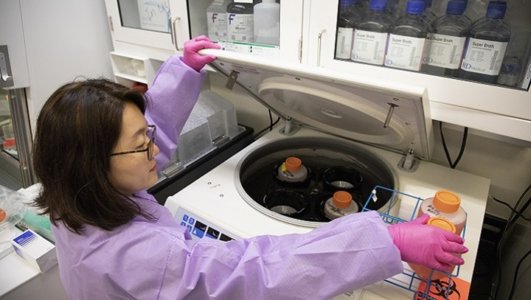In June, a U.S. Army laboratory, the Walter Reed Army Institute of Research (WRAIR), a subordinate command of the Army Futures Command’s Medical Research and Development Command (USAMRDC), announced the selection of a lead COVID-19 vaccine candidate as well as two backup vaccine candidates that will advance to the next stage of research.
“USAMRDC is moving at unprecedented speeds in the effort to prevent, detect, and treat COVID-19. We are supporting the whole-of-government response with the scientific knowledge and expertise to combat this world-wide challenge,” said Brigadier General Michael J. Talley, commanding general of the USAMRDC and Fort Detrick. “With the recent selection of this vaccine candidate, we believe we are one step closer to that goal.”
The candidates were narrowed down from more than two dozen prototypes in order to determine the candidates that elicited the most promising antibody response in preclinical studies. The leading candidate is called SpFN, for Spike Ferritin Nanoparticle, and will enter first-in-human testing later this year.
“As soon as the virus sequence was published in January 2020, WRAIR began conceptualizing a vaccine strategy,” said Dr. Kayvon Modjarrad, director of the Emerging Infectious Diseases Branch (EIDB) of WRAIR. “We have leveraged the Institute’s expertise and infrastructure to be able to compress what would, under normal circumstances, be two years of discovery and design work into several months.”
In an interview in July on Real Vision, Dr. Modjarrad commented, “Even if we assume that we’re missing a lot of the cases, that the number of cases overall is much higher than we’re detecting, if we’re pretty conservative and say, okay, it’s five to 10 times more number of cases, that still means that the mortality from this particular coronavirus is five to 10 times more than seasonal influenza. That’s huge. When you think of the world’s population, if we’re talking about point 5%, we’re talking about 10s of millions of people who still could die from this disease. Our greatest fears were realized with this particular virus, something that was more transmissible than any of the other coronaviruses and much more so than influenza, but just as deadly or even more deadly than a lot of the flu strains we saw in the past.”
The vaccine is unique due to its ferritin nanoparticle platform that has been engineered to present specific pieces of the coronavirus spike protein (the part of the virus that attaches to the lungs) to the immune system. Researchers hope the ferritin vaccine platform could pave the way for a universal vaccine to protect against not only the current virus, but also other known and unknown coronaviruses that could arise in the future.
WRAIR’s vaccine is paired with a proprietary adjuvant, the Army Liposome Formulation (ALF), to further boost the immune response. This adjuvant, developed by Army scientists at WRAIR, has generated strong immune responses in preclinical studies.
“The vaccine that we have developed at WRAIR is exciting, but that is not the only way that the U.S. Army will contribute to COVID-19 vaccine development,” said Dr. Nelson Michael, director of the Center for Infectious Diseases Research at WRAIR. “We are heavily involved in detailed planning with our interagency partners to test the most promising COVID-19 vaccines at our clinical trial sites in the U.S. and around the world to ensure that we can deliver a safe, effective, and accessible vaccine in the shortest possible time.”
USAMRDC is also supporting Operation Warp Speed, an intergovernmental effort aimed at accelerating the development, manufacturing, and distribution of COVID-19 vaccines, therapeutics, and diagnostics.The command is providing subject matter expertise in research, development, and acquisition with a unique, life-cycle approach.
About WRAIR: The Walter Reed Army Institute of Research dates back to 1893. Around the world, WRAIR works alongside civilian researchers, medical professionals, and military personnel to develop and test products that will ultimately reduce the impact of some of the most dangerous and debilitating diseases. WRAIR provides unique research capabilities and innovative medical solutions to a range of Force Health Protection and Readiness challenges currently facing U.S. Service Members, along with threats anticipated during future operations. WRAIR has created a model of vaccine and therapeutic development that is unique, nimble, and responsive to dynamically evolving infectious disease threats of military importance. WRAIR, with its unparalleled expertise, facilities, and international network, has developed many vaccines and drugs in use today by military and civilian medicine around the globe.
About USAMRDC: The U.S. Army Medical Research and Development Command is the Army’s medical materiel developer, with responsibility for medical research, development, and acquisition. The USAMRDC’s expertise in these critical areas helps establish and maintain the capabilities the Army needs remain ready and lethal on the battlefield. Ensuring our armed forces remain in optimal health and are equipped to protect themselves from disease and injury, particularly on the battlefield, is the job of the U.S. Army Medical Research and Development Command. The Command is headquartered at Fort Detrick, MD, with subordinate commands located throughout the world. The Command is staffed with highly qualified scientists, program managers, acquisition experts, and support personnel. The critical expertise in these areas ensures we have the medical capabilities the Army needs to fight and win on the battlefield. From illness to injury, the U.S. Army Medical Research and Development Command is the only organization solely focused on research and development to address the military’s unique medical readiness requirements.
Image Source: DOD. Misook Choe, a laboratory manager with the Emerging Infectious Disease branch at the Walter Reed Army Institute of Research in Silver Spring, Md., runs a test during research into a solution for the new coronavirus, COVID-19, March 3, 2020.
